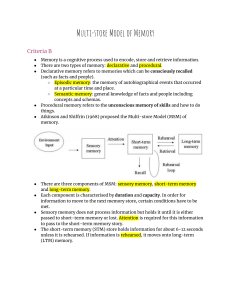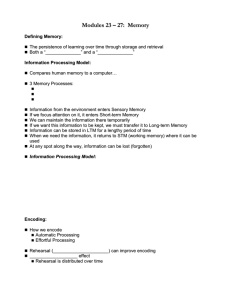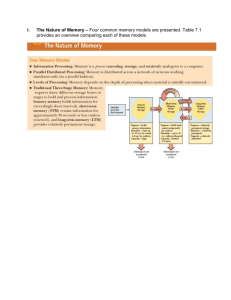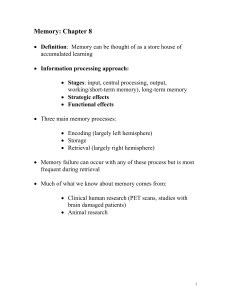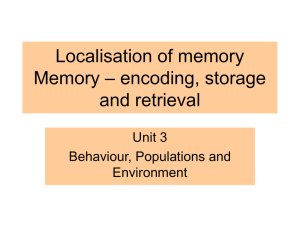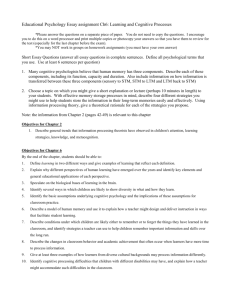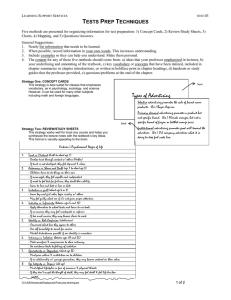Memory
advertisement
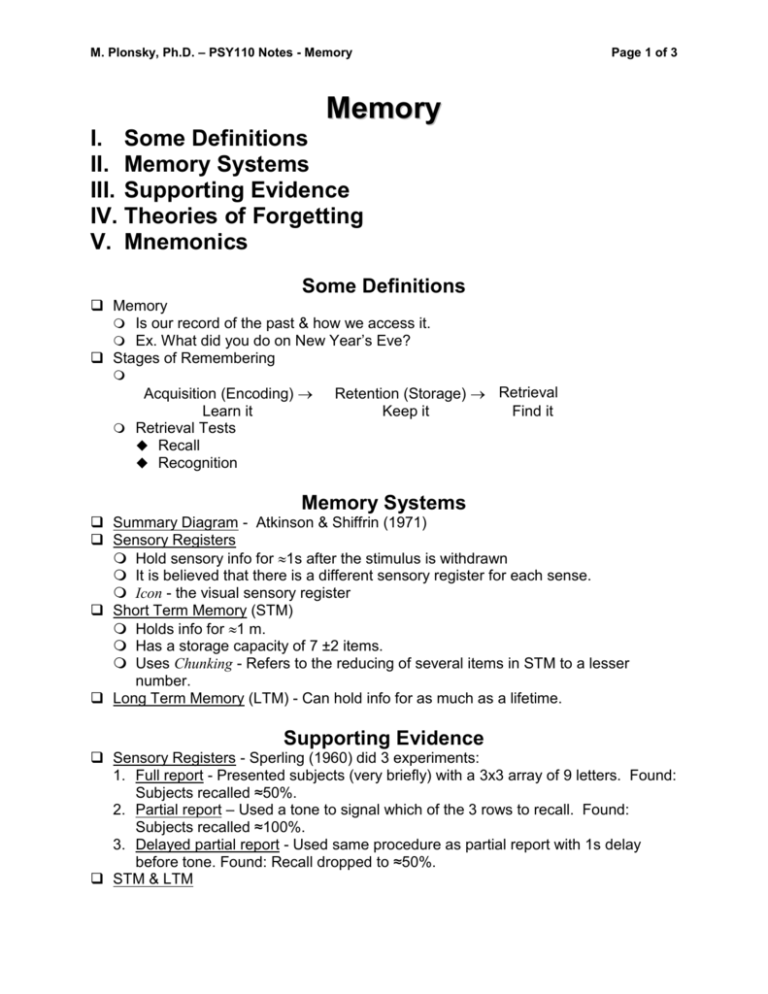
M. Plonsky, Ph.D. – PSY110 Notes - Memory Page 1 of 3 Memory I. Some Definitions II. Memory Systems III. Supporting Evidence IV. Theories of Forgetting V. Mnemonics Some Definitions Memory Is our record of the past & how we access it. Ex. What did you do on New Year’s Eve? Stages of Remembering Acquisition (Encoding) Learn it Retrieval Tests Recall Recognition Retention (Storage) Retrieval Keep it Find it Memory Systems Summary Diagram - Atkinson & Shiffrin (1971) Sensory Registers Hold sensory info for 1s after the stimulus is withdrawn It is believed that there is a different sensory register for each sense. Icon - the visual sensory register Short Term Memory (STM) Holds info for 1 m. Has a storage capacity of 7 ±2 items. Uses Chunking - Refers to the reducing of several items in STM to a lesser number. Long Term Memory (LTM) - Can hold info for as much as a lifetime. Supporting Evidence Sensory Registers - Sperling (1960) did 3 experiments: 1. Full report - Presented subjects (very briefly) with a 3x3 array of 9 letters. Found: Subjects recalled ≈50%. 2. Partial report – Used a tone to signal which of the 3 rows to recall. Found: Subjects recalled ≈100%. 3. Delayed partial report - Used same procedure as partial report with 1s delay before tone. Found: Recall dropped to ≈50%. STM & LTM M. Plonsky, Ph.D. – PSY110 Notes - Memory Page 2 of 3 Free Recall Studies - Murdock (1962) 1. Standard – demo (20 words 2 sec apart), words, findings. Demonstrates Primacy Effect (perhaps due to LTM storage) & Recency Effect (perhaps due to STM storage). 2. 30-sec delay - illuminates recency effect. 3. Slow vs. fast presentation - improves primacy effect. Physiological Evidence - 2 types: 1. Anterograde Amnesia Lack memory for the immediate future. Classic case - hippocampectomy. Subject cannot learn anything new. Nothing can be moved from STM to LTM. 2. Retrograde Amnesia Lack memory for immediately preceding events. Classic case - bump on the head. Subject never consolidates the info (moves it from STM to LTM). Theories of Forgetting There are at least 3: 1. Decay Memory traces gradually decay as a result of metabolic processes. Data suggests that a cold fish remembers better than a hot fish. (Cold fish has slower metabolism.) 2. Interference Forgetting occurs because old memories are misplaced by new ones. Data suggests that sleeping humans remember better than awake humans. Are 2 types of interference: 1. Retroactive - New learning hampers the recall of old material. 2. Proactive - Old learning hampers new learning. Thus, retroactive interference is central to the interference theory of forgetting. 3. Retrieval Cues In order to remember we need retrieval cues & these become less available over time. One interesting type of retrieval cue is your mental state. State Dependent Memory Says memory (retrieval) works better when you are in the same state as during recall as during acquisition. Applies to drugs, mood, music, place, odor, etc. Mnemonics (ways to improve memory) Several types: 1. Acronyms - Abbreviations. - Ex. MADD, UWSP, Roy G. Biv, etc. 2. Verse - Rhymes. - Ex. Thirty days has September . . . 3. Organization - Outlines. Ex. This lecture, Taxonomy in biology. 4. Visual Imagery - are several. Exs.: Method of Loci - Visualize each item in a different spatial location. M. Plonsky, Ph.D. – PSY110 Notes - Memory Peg Method Create mental “pegs” for attaching to items. Ex. Peg Item to Memorize one - bun college Eating a bun in the college snack bar. two - shoe earthworm Stepping on an earthworm with my shoe. three - tree tophat My tophat was green like the tree leaves. Page 3 of 3





